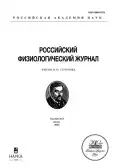Влияние консервации на изменение объема клеток эндотелия роговицы в среде с высокой концентрацией калия
- Авторы: Каткова Л.Е.1, Батурина Г.С.1,2, Тетерин М.М.3, Саханенко А.И.4, Пальчикова И.Г.2,5, Искаков И.А.6, Соленов Е.И.1,2,3
-
Учреждения:
- Институт цитологии и генетики Сибирского отделения Российской академии наук
- Новосибирский национальный исследовательский государственный университет
- Новосибирский государственный технический университет
- Институт математики им. С. Л. Соболева Сибирского отделения Российской Академии наук
- Конструкторско-технологический институт научного приборостроения Сибирского отделения Российской академии наук
- Межотраслевой научно-технический комплекс «Микрохирургия глаза» им. акад. С. Н. Федорова Минздрава России
- Выпуск: Том 110, № 8 (2024)
- Страницы: 1264-1272
- Раздел: ЭКСПЕРИМЕНТАЛЬНЫЕ СТАТЬИ
- URL: https://modernonco.orscience.ru/0869-8139/article/view/651625
- DOI: https://doi.org/10.31857/S0869813924080041
- EDN: https://elibrary.ru/BCCLKP
- ID: 651625
Цитировать
Полный текст
Аннотация
Проведено экспериментальное исследование воздействия высокой (100 мM) концентрации калия в среде на объем клеток эндотелия роговицы человека в зависимости от времени холодовой консервации донорского препарата. Приведены результаты исследования единичных образцов и значения, полученные на объединенном материале фрагментов донорских образцов после содержания препаратов в консервационной среде при 4 ℃ в течение 4 и 10 дней. Увеличение времени холодовой консервации препаратов привело к снижению процента клеток, способных набухать в среде с повышенным содержанием ионов калия (94.3% и 56.8% после 4 и 10 дней соответственно). Исследование клеток, способных к набуханию, показало, что увеличение времени их холодовой консервации привело к снижению средней величины (M ± SEM) коэффициента набухания клеток в среде с высокой концентрацией калия с 1.055 ± 0.001 до 1.014 ± 0.001 после 4 и 10 дней соответственно. Высокую степень достоверности различия этих значений (p-value = 2E-76) показали с помощью t-критерия Стьюдента для независимых выборок.
По результатам исследования высказывается предположение, что величины набухания клеток эндотелия в калиевой среде могут служить показателями способности клеток к восстановлению электрогенного транспорта. Делается заключение, что исследование реакции клеток эндотелия роговицы на повышение концентрации ионов калия в среде может давать информацию для прогноза функциональности трансплантата.
Ключевые слова
Полный текст
Об авторах
Л. Е. Каткова
Институт цитологии и генетики Сибирского отделения Российской академии наук
Email: eugsol@bionet.nsc.ru
Россия, Новосибирск
Г. С. Батурина
Институт цитологии и генетики Сибирского отделения Российской академии наук; Новосибирский национальный исследовательский государственный университет
Email: eugsol@bionet.nsc.ru
Россия, Новосибирск; Новосибирск
М. М. Тетерин
Новосибирский государственный технический университет
Email: eugsol@bionet.nsc.ru
Россия, Новосибирск
А. И. Саханенко
Институт математики им. С. Л. Соболева Сибирского отделения Российской Академии наук
Email: eugsol@bionet.nsc.ru
Россия, Новосибирск
И. Г. Пальчикова
Новосибирский национальный исследовательский государственный университет; Конструкторско-технологический институт научного приборостроения Сибирского отделения Российской академии наук
Email: eugsol@bionet.nsc.ru
Россия, Новосибирск; Новосибирск
И. А. Искаков
Межотраслевой научно-технический комплекс «Микрохирургия глаза» им. акад. С. Н. Федорова Минздрава России
Email: eugsol@bionet.nsc.ru
Новосибирский филиал
Россия, НовосибирскЕ. И. Соленов
Институт цитологии и генетики Сибирского отделения Российской академии наук; Новосибирский национальный исследовательский государственный университет; Новосибирский государственный технический университет
Автор, ответственный за переписку.
Email: eugsol@bionet.nsc.ru
Россия, Новосибирск; Новосибирск; Новосибирск
Список литературы
- Maurice DM (1972) The location of the fluid pump in the cornea. J Physiol 221: 43–54. https://doi.org/10.1113/jphysiol.1972.sp009737
- Bonanno JA (2012) Molecular mechanisms underlying the corneal endothelial pump. Exp Eye Res 95: 2–7. https://doi.org/10.1016/j.exer.2011.06.004
- Klyce SD (2020) Endothelial pump and barrier function. Exp Eye Res 198: 108068. https://doi.org/10.1016/j.exer.2020.108068
- Srinivas SP (2010) Dynamic regulation of barrier integrity of the corneal endothelium. Optom Vis Sci 87: E239–Е254. https://doi.org/10.1097/OPX.0b013e3181d39464
- Verkman AS, Ruiz-Ederra J, Levin MH (2008) Functions of aquaporins in the eye. Prog Retin Eye Res 27: 420–433. https://doi.org/10.1016/j.preteyeres.2008.04.001
- Hoffmann EK, Lambert IH, Pedersen SF (2009) Physiology of cell volume regulation in vertebrates. Physiol Rev 89: 193–277. https://doi.org/10.1152/physrev.00037.2007
- Wehner F, Shimizu T, Sabirov R, Okada Y (2003) Hypertonic activation of a non-selective cation conductance in HeLa cells and its contribution to cell volume regulation. FEBS Lett 551: 20–24. https://doi.org/10.1016/s0014–5793(03)00868–8
- Hoffmann EK (2011) Ion channels involved in cell volume regulation: effects on migration, proliferation, and programmed cell death in non adherent EAT cells and adherent ELA cells. Cell Physiol Biochem 28: 1061–1078. https://doi.org/10.1159/000335843
- Борзенок СА, Малюгин БЭ, Гаврилова НА, Комах ЮА, Тонаева ХД (2018) Алгоритм заготовки трупныx роговиц человека для трансплантации: Методические рекомендации. Москва. Офтальмология. [Borzenok SA, Maljugin BJ, Gavrilova NA, Komah JA, Tonaeva HD (2018) Algorithm for harvesting cadaveric human corneas for transplantation: Guidelines. M. Oftalmologija. (In Russ)].
- Mori Y (2012) Mathematical properties of pump-leak models of cell volume control and electrolyte balance. J Math Biol 65: 875–918. https://doi.org/10.1007/s00285–011–0483–8
- Solenov E, Watanabe H, Manley GT, Verkman AS (2004) Sevenfold-reduced osmotic water permeability in primary astrocyte cultures from AQP-4-deficient mice, measured by a fluorescence quenching method. Am J Physiol Cell Physiol 286: C426-C432. https://doi.org/10.1152/ajpcell.00298.2003
- Zarogiannis SG, Ilyaskin AV, Baturina GS, Katkova LE, Medvedev DA, Karpov DI, Ershov AP, Solenov EI (2013) Regulatory volume decrease of rat kidney principal cells after successive hypo-osmotic shocks. Math Biosci 244: 176–187. https://doi.org/10.1016/j.mbs.2013.05.007
- O’Neill WC (1999) Physiological significance of volume-regulatory transporters. Am J Physiol Cell Physiol 276: C995–C1011. https://doi.org/10.1152/ajpcell.1999.276.5.C995
- Strange K (2004) Cellular volume homeostasis. Adv Physiol Educ 28: 155–159. https://doi.org/10.1152/advan.00034.2004
- Jentsch TJ, Maritzen T, Zdebik AA (2005) Chloride channel diseases resulting from impaired transepithelial transport or vesicular function. J Clin Invest 115(8): 2039–2046. https://doi.org/10.1172/JCI25470
Дополнительные файлы










